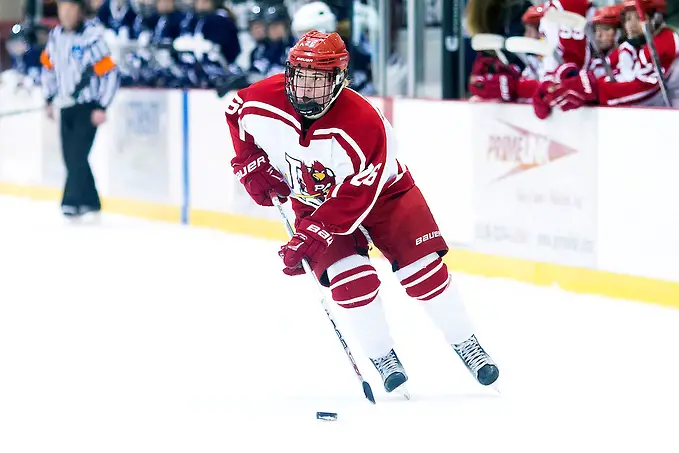
With conference tournaments wrapping up this weekend, it’s time to turn our eyes to the national scene. The Division III women’s tournament selection show takes place Monday morning, March 5 , at 10 a.m. EST.
The DIII tournament, by its design, changes from year to year. Thanks to D3hockey.com for breaking down this year’s differences. One of the biggest changes is that this season, there will be nine bids given to the NCAA D-III Tournament. That means there will be a first-round, play-in type game that will take place a day prior to the quarterfinal games.
In years past, a team was only considered a “ranked team” if they appeared on the final ranking, which was not publicly published. This year, teams appearing on either of the final two NCAA regional rankings will be considered ranked, and that final regional ranking will be made public. You can find regional rankings here.
Normally, autobids (Pool A bids) are only given to conferences that have played with the same seven or more members for at least two years. There has been quite a bit of conference upheaval in recent seasons. This year, the NEWHL has been granted a waiver, and their conference champion will receive an autobid, despite only have five teams in the conference currently.
The D-III conference format is anything but easy to understand. The final field is determined by bids awarded to three different pools of teams. The first is Pool A. These are the six bids given automatically the winners of the CHC, MIAC, NEHC, NESCAC, NEWHL, and NCHA postseason tournaments.
The number of Pool B bids is determined by how many teams are currently playing and how many are playing in those Pool A conferences. It gets a little complicated, but just know that this year, a single Pool B bid is available, and it goes to a team not in one of the Pool A conferences or an independent. This year, that means teams playing in the UCHC and WIAC.
Pool C bids are given out using the same criteria that will be used to seed the final nine teams and create the final NCAA tournament bracket.
Those criteria are:
- Win-lost percentage against Division III opponents (WIN)
- Division III head-to-head competition (H2H)
- Results versus common Division III opponents (COP)
- Results versus ranked Division III teams as established by the rankings at the time of selection; conference postseason contests are included (RNK)
- Division III strength of schedule (SOS)
This is where both what it means to be a ranked team and having the final rankings published will be particularly poignant. There are two regional committees who rank teams in their own region four times a year. Those regional rankings and no other poll is what is used to determine a team’s results versus ranked D-III opponents.
For now, we’ll assume the Pool A bids will go to the top team in each conference. While upsets are certainly possible (the most likely being Hamline over Gustavus Adolphus in the MIAC), for now we’ll assume the no. 1 seeds in each of these conference tournaments take the championship.
That means Morrisville (CHC), Plattsburgh (NEWHL), Gustavus Adolphus (MIAC), Adrian (NCHA), Norwich (NEHC), and Middlebury (NESCAC) will each have bids to the NCAA tournament.
The shakeup in conferences could have a detrimental effect on perennial powerhouse Wisconsin-River Falls. The new UCHC is up for the Pool B bid, and their front-runner is Elmira. The Soaring Eagles have spent the season ranked in the top three nationally, and they beat Wis.-River Falls in nearly every selection criteria.
Elmira gets the Pool B bid, so that’s seven of the nine tournament teams.
Wis.-River Falls does get a second chance with the at-large Pool C bids. By the time this column publishes, D3hockey.com will likely have a new Bracketology out (I highly recommend this for trying to pick your way through the often-changing D-III postseason landscape). For the moment, it looks like those two bids will go these six teams — Amherst, Connecticut College, Hamilton, Hamline, Wisconsin-Eau Claire, and Wisconsin River Falls.
Playing in the smaller WIAC, Wisconsin-River Falls has smartly filled it’s nonconference schedule with contests against some of the best teams in the country, and that proves to be very important for them here. None of the remaining teams can compare to their résumé when it comes to strength of schedule, wins over ranked teams, and overall win percentage. It seems likely that Wis.-River Falls will get a Pool C bid. It would be a shocker if they did not. It would be the first time the Falcons don’t make the NCAA tournament since 2008.
That could absolutely change. Last week, Connecticut College wasn’t even in this at-large bid conversation, but a single swap in the East rankings has them on the edge of a Pool C spot.
It’s my opinion that we won’t know who that final at-large bid will go to until the very last moment. It’s too close to call, and any conference tournament upsets or changes to the regional rankings will undoubtedly have an impact.


